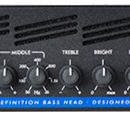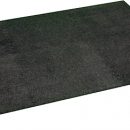The Ibanez RG dates back to the late ‘80s. Trivia: Did you know RG stands Roadstar Guitar? It was an affordable yet quality solution for working musicians who needed great playing/sounding guitars that didn’t break the bank. The RG line of guitars became an instant hit, and nearly three-decades later, the line has something for discerning rock guitarists at any level.
Eventually, seven-string guitars were added to the RG line, and now, Ibanez has continued to innovate around this popular platform with the RGIF7, a seven-string, multi-scale guitar that features fanned frets.
Fanned frets seem to be all the rage today, and there is some merit to the design. Changing the orientation of the frets across the neck improves intonation while also improving player comfort. If you’ve been curious about the recent assault of fanned fret offerings in the marketplace, the RGIF7 comes in at a price point that makes it easy to experiment.
This particular guitar is marketed to a very particular user base (seven-string, metal shredders) who should quickly find value in this guitar. It’s a good first attempt by a major builder to provide a mass produced, fanned fret instrument, and we were impressed enough by the ergonomic advantage that we would love to see fanned fret guitars introduced across other non-metal lines such as the S series, Jems, and more.
[Editor’s Note: Nobody has been talking about this, but we also wonder if there’s a physical, medical advantage here for players who suffer from carpel tunnel and other wrist-related injuries? If you’re a guitarist and a doctor, we encourage you to buy one of these instruments—how often do you get to write off a guitar as a business expense?—and decide just how helpful this new design approach can be.]Features
 The Ibanez RGIF7 Multi Scale guitar arrived dressed in a black stain on ash finish, with seemingly crooked frets. This is not an instrument we are accustomed to seeing, and in more ways than one! Ash is not typically an aesthetically striking piece of wood, and while we can see how the understated finish appeals to certain crowds, it’s certainly not for everyone. We would love to see this instrument offered in more traditional, solid finishes as well.
The Ibanez RGIF7 Multi Scale guitar arrived dressed in a black stain on ash finish, with seemingly crooked frets. This is not an instrument we are accustomed to seeing, and in more ways than one! Ash is not typically an aesthetically striking piece of wood, and while we can see how the understated finish appeals to certain crowds, it’s certainly not for everyone. We would love to see this instrument offered in more traditional, solid finishes as well.
The Nitro Wizard 7, multi-scale, five-piece maple/bubinga neck is unique to this instrument. It is essentially multi-scale due to the fanned fret design. The bass side has a long 27” scale, while the treble end is a familiar 25.5” length. A rosewood fingerboard with no markings on the board (we imagine to flow with the guitars minimalist appearance) and polished, jumbo frets finish out the neck.
A set of EMG active 808X neck and bridge pickups are appropriately fanned on the body of the guitar, as is the Mono Rail bridge. The Mono Rail bridge is designed to isolate individual string vibration, having no saddle affected by another string being struck. One volume and one tone knob is all it takes to control this seven-string metal machine.
Picking switching is as straightforward as it gets: a three-way selection between bridge-only, bridge and neck, and neck-only operation.
The non-locking nut appears to be plastic and is fanned appropriately along the pitch of the first fret.
The back of the guitar features string-thru holes, a battery compartment for the EMG active pickups, and a control cavity. No clunky neck heel here—the neck joint is recessed for easy upper register access. The five-piece neck design is obvious from the back of the instrument, and is a tried-and-true winner in terms of stability and aesthetic appeal.

Usability
The seven-string guitar in and of itself takes a little getting used to for the traditional six-string player. Owning many seven-string instruments (including a ‘90s-era Ibanez RG and a GMC77 Universe), the transition to this latest RG was both familiar and quick. Within an hour, the neck felt comfortable to play. Typical of Ibanez craftsmanship, we appreciated the fret edges and feel of the neck in general. The frets were smooth to the touch and the neck profile was one of the most comfortable 7s we have played. Tuning stability was rock solid thanks to the Mono Rail bridge, and the nut is cut to eliminate any pinging or string binding. All in all, we feel this is as solid a seven-string as any other RG we have played.
The multi scale/fanned fret design came with some pros and cons. We loved the way the frets are ergonomically positioned for the left hand as we played up the neck. It definitely provides a more comfortable and natural playing experience over traditionally fretted instruments. Try this exercise: fret a bar chord high up on your guitar neck, very loosely so that you’re not really fretting. Slide your hand down the neck towards the first fret. You should find that your wrist hand has a natural inclination to shift into a more comfortable angle that does not have your pointer finger perfectly perpendicular to the guitar neck… you slide into an angle that is more natural the greater the reach. You’ve now just experienced the fanned fret design advantage!
 There is literally no break in transitional period where the fanned frets feel out of place. The fanned fret design is not a gimmick; there is something to it in terms of a more enjoyable and organic feel. Whether or not the guitar community embraces it or not remains to be seen. We are not suggesting getting rid of your traditionally fretted instruments, but we quickly see the wisdom in having the frets follow your wrist and not vice versa.
There is literally no break in transitional period where the fanned frets feel out of place. The fanned fret design is not a gimmick; there is something to it in terms of a more enjoyable and organic feel. Whether or not the guitar community embraces it or not remains to be seen. We are not suggesting getting rid of your traditionally fretted instruments, but we quickly see the wisdom in having the frets follow your wrist and not vice versa.
What we found a little cumbersome was specific to this particular guitar’s design aesthetics: the lack of any fretboard position markings. While the side binding typically has dot markers; there are none on this neck at all! We love a minimalist fretboard design, but on an instrument with such a long scale on the bass side, we needed a little better visual mapping for the fretboard of this guitar.
Consider this: On a traditional guitar, all frets are aligned vertically across the fretboard. If you’re on the fifth fret, low E or B string, you bar a chord and you’re still fretting a note on the fifth fret of the high E string. On a multi scale neck, that’s no longer the case! The fifth fret on the low B string of this guitar is actually directly aligned with the fourth fret on the high E string! Position markers would have eliminated a few we’re-not-playing-jazz mistakes on our part. To be perfectly clear, we do like seven-string guitars, and we also like fanned frets. So let’s get some better combinations of form and function, Ibanez! And let’s see this on a six-string guitar, too!
The guitar was lightweight for a seven-string RG and was very comfortable to play standing or seated. Tuning remained stable throughout product testing.
Sound
The Ibanez RGIF7 Multi Scale was clearly designed for high-gain rock. EMG pickups? Check. Seven string? Check. Our gnarliest metal face? Check. We first plugged our test instrument into a Marshall JCM900 MKIII with a 1960BX cabinet. Not quite the highest gain setup we have, but this combination has pumped out enough great tones in the past.
With the gain knob at seven, the guitar sounded even and compressed throughout its range. We expected this with the 808 pickups, and they preformed as anticipated. The Marshall is not a very tight sounding amp, but low B staccato lines held tight and articulate nevertheless. Nudging the gain all the way up, at a decent volume the guitar fed back in a pleasing way. The EMGs are a little on the bright side, but for the target player of this instrument, they’re a good choice. No mud to be found, and especially in an extended range guitar, is a clear winner. Rolling the volume back on the guitar just a little bit eliminated all feedback from this amp and kept its signature sound and presence. But let’s face it… most players of this guitar may not even notice there’s a volume knob.
Our next sound test was a better suited to this guitar. We plugged the instrument into our Mesa/Boogie Mark Five mated with stereo cabs (An oversized Recto cab and a 4x10 Marshall lead cab). On channel 1, the cleans sparkled very nicely out of the center pickup position. We felt it was a good balance of harmonic complexity and rich overtones. Playing with effects from Eventide and TC Electronic made us want this an inspired pairing.
Our next sound test was through the third channel of the Mark Five. We set the voicing switch to Insane and chugged out some low B venom. Insane is an understatement! This is what the instrument was designed for. The pickup selection for this instrument became apparent under true high-gain conditions. Lead lines sung through nicely as well. The pickups were quiet, yet retained a bold characteristic. We also felt there was indeed something to the Mono Rail bridge in regards to separation of string vibration. For a guitar this light, it seemed to come across with more sustain than it should. We think the saddle isolation had something to do with that.
Our last sound test was with the guitar plugged into a Friedman SS 100 mated up to a 4x12 Greenback-equipped cabinet. Firing up the dirty channel, the EMG pickups pushed this amp in a very pleasing way. Without engaging the boost channel, the signal already sounded boosted and pushed compared to an Ibanez Jem with Dimarzio Gravity Storm passive pickups. Engaging the SS boost pushed the amp into molten thick gain, with feedback easily occurring if we weren’t careful. In our high-gain amps, dialing back the guitar’s volume did not produce as pleasing results as we found with passive pickups, however.
Documentation and Product Support
Ibanez included a multi-language manual explaining the basics of our test guitar’s care and operation. And, they have a very extensive website with loads of content should you need some further assistance.
Price
The Ibanez RGIF7 Multi Scale (MSRP $1,377.76) sells for just under $1,000. We feel this is a very good value for a guitar which has no equal in the Ibanez product line. Seven-stringed, fanned fret instruments are not yet very common, and thoughtfully Ibanez has not built a premium price into the product. The RGIF7 is a sure winner (in our opinion) if you’re ready to try something a bit different.
Contact Information
Ibanez
www.ibanez.co/usa
Overall Rating - Product Summary
| Category | Value | Rating |
| Features | 20% | |
| Usability | 25% | |
| Sound | 25% | |
| Documentation & Support | 10% | |
| Price | 20% | |
|
|
||
| OVERALL RATING = 3.4 Stars
3.6 stars or better: Outstanding, WIHO Award
|
||
















